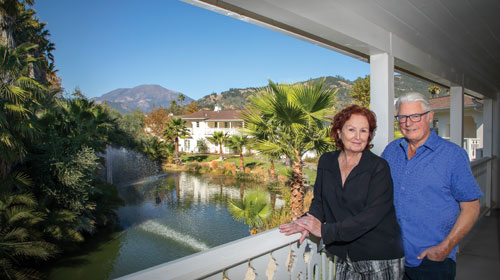Since the early 1860s, the 17-acre geyser-fed Indian Springs Resort has welcomed people from near and far to come, relax and restore themselves. Located at the top end of the Napa Valley, in the City of Calistoga, the resort is surrounded by hills, trees and spewing geysers. Today, it occupies the exact spot chosen by the founder of Calistoga, the colorful Sam Brannan, when he came to the area in the mid-1800s and fell in love with the potential of the place.
Brannan, a Mormon from Maine, journeyed west on a religious mission, which he eventually abandoned, founding California’s first newspaper in San Francisco before heading to Sacramento to seek his fortune in gold. Through his clever entrepreneurship he prospered, becoming the first millionaire in California.
A Saratoga-style resort
In 1859, Brannan ventured north into the Napa Valley. When he reached the head of the valley and the beautiful land of geysers and forests and volcanic ash, he was reminded of the great resorts in the east, especially Saratoga Springs in New York. Brannan saw potential for a great resort that the wealthy would come to, as they did in the east, for respite and restoration of their bodies and souls. Having money to spare, he purchased 2,000 acres that was to become Calistoga. This, he knew, would be the ideal situation for a great spa where city dwellers could relax—“take the waters,” as they said during that time in history—and restore themselves. Legend has it that he so loved the idea of a Saratoga-style resort in California that he combined the words Saratoga and California—some say in a drunken tongue-twisted malapropism—creating name “Calistoga,” which he gave to the new city he had founded.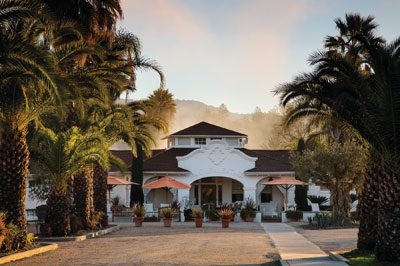
In 1861, on the same site where Indian Springs Calistoga is now, Brannan built his own resort spa and splash pool. In time, as Brannan moved forth to other adventures, the resort changed hands, and in 1905 the Pacheteau family bought it and named it Pacheteau Baths. By 1988, the 16-room Pacheteau Baths was put up for sale again.
“It was the time of the failing S&L’s,” says the resort’s current owner, John Merchant. At the time, he was working on urban renovations in San Francisco, creating places with retail on the ground floors and residences above. The Merchants owned a home in St. Helena. One summer they were adding a pool, and while they were waiting for theirs to be completed, they would swim at Indian Springs. “John fell in love with the place and swore if [the resort] was ever for sale, he would buy it.” Six months later, he received a call. The resort was for sale.
Though John wasn’t a hotel manager or spa-goer, he realized the rare opportunity this held. He and his wife, Pat, leapt at the chance to save and restore the unique Napa Valley landmark and asked a friend, Kathy Nelson, in San Francisco to come up and be the manager. “She had a small spa in San Francisco, and came up and taught us the business,” says Pat. They wanted to be in a healing atmosphere, immersed in nature, right in the middle of a small, historic town. They expanded and improved the grounds, building on the existing plan. The architecture remains Mission Revival, and the huge, pristine white pool is exactly the same as it was back in 1910, thanks to careful upkeep.
The resort opened with 16 rooms, a spa and the great, geyser-fed mineral pool with four employees, and suddenly the Merchants found themselves in the spa business. “And we’re still in the business,” says John. For them, the operation was a steady progression upward, always keeping a feeling of calm and continuity. When the times were right, they expanded and to meet the ever-increasing demand for a place to relax immersed in nature, right in the middle of a small, historic town just as Brannan envisioned.
Not surprisingly, Indian Springs is a resort that guests enjoy returning to again and again. “Our guests like Calistoga,” says John. “But they also like Indian Springs.” He prides himself on the return trade. “It’s family friendly. [Guests] love our historic pool. It’s warm, you can swim year-round. They love the Mission Revival style architecture.” When guests arrive, they understand that this is a family-run place where everyone is welcoming and is glad to see you. It’s not a chain operation, run by an out-of-state or out-of-country consortium. “People like the fact that we’re an independent,” he adds. “That’s a whole different feel.
Visitors travel from San Francisco, from afar, and from neighboring counties, for 30 years. “They like to come here,” says John. “It’s their favorite place. Once they get here, our pool is 100 degrees in the wintertime. You can swim until midnight.”
The expansion
As the demand for the Indian Springs experience increased, the Merchants expanded the property, keeping the historical feel. In 2004, they purchased the adjoining property and renovated it, creating what is now The Lodge, adding 24 more rooms. And in 2016, they expanded again, adding 75 more rooms and a restaurant, Sam’s Social Club – named for Sam Brannan – with a bright, spacious, friendly interior and dining patio outside. “This was a big expansion,” says John. In 1988, they had four employees. Now, they have 220 employees.
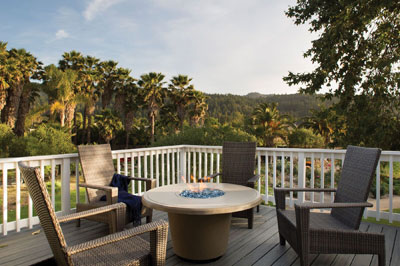 According to John, more than 30 to 40 percent live locally, and more than 100 rooms available include individual cottages, bungalows, the Lodge, and two unique houses. “It’s a much bigger operation,” says Merchant. “We have 85 percent occupancy right now. And we’re still in the business, and we still love the business.”
According to John, more than 30 to 40 percent live locally, and more than 100 rooms available include individual cottages, bungalows, the Lodge, and two unique houses. “It’s a much bigger operation,” says Merchant. “We have 85 percent occupancy right now. And we’re still in the business, and we still love the business.”
It sounds like a lot, but as you walk the winding paths around the grounds, the cottages blend in with the landscaping and the individual buildings, while all in the Mission Revival style, feel unique, but within a historic context. Everything outside is bright white and, when you enter any of the rooms, the interiors are warm, colorful and fresh. The feeling of history of the architecture is balanced with the fresh newness of the fabrics and textures of the interiors. John Merchant says his wife, Pat, has a lot to do with the aesthetic success of the place.
“I always think about how important history is—the old spa and the ritual of the mud bath and how it harkens back to another day,” says Pat. There are not too many places anymore that have tried to preserve the past and make it work in the present. It’s an “homage to the past,” says Pat, that you feel while being very much in the present. When guests arrive, the resort offers a welcome respite.
At the resort, guests lounge in hammocks or chaises in front of the white cottages. They’re strolling along the paths in robes and flip-flops in perfect comfort. A small garden full of blossoming flowers is designed for children to enjoy, and a small chicken coop with a few tame hens is fun for everyone.
Guests scheduled for spa treatments can enjoy the Buddha Pond, which is a quiet, deeply serene spot where you may hear the plunk of frogs. The pool is mammoth, and the same as it was more than a century ago with amazing blue water and the geyser huffing in the background. Guests are floating in the blue water, lounging, talking and reading, and seem to be spending hours just soaking up the minerals and relaxing.
“That’s the idea of Indian Springs,” says Pat. “We hope our guests will feel that Indian Springs is their place in the country. That’s why we talk about our family a lot. When we bought it, two of our kids were young. Kids can be freewheeling up here.”
The sense of history blends with the feeling you get when you’re out at the pool, or in the cottages, says Pat, where all the surfaces are new, bright and clean. The cottages are in the Mission style but there is nothing “historic” about the atmosphere. “We’re always refreshing,” she says. “When I walk into a [guest unit] and see something that seems worn, I’ll have it redone.”
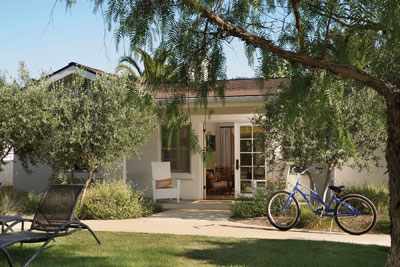 The spaces are efficiently designed to accommodate different configurations of guests. Some feature bunk beds for kids. “It’s a little bit of the past with present amenities,” she says. Colors play an important part in the feel of the place, both in maintaining the traditional sense and also ensuring that the style is up to date. “We’re about to do a reboot of the restaurant,” says Pat. It’s a pleasure for her, working with designers, making sure the feel, the ambiance of every room is right. “I love color, and I love making something beautiful,” she says. “I love preserving—rescuing. When we first bought the property, people said, ‘Oh, you should just tear it down.’ But we rescued it and brought it back to life.”
The spaces are efficiently designed to accommodate different configurations of guests. Some feature bunk beds for kids. “It’s a little bit of the past with present amenities,” she says. Colors play an important part in the feel of the place, both in maintaining the traditional sense and also ensuring that the style is up to date. “We’re about to do a reboot of the restaurant,” says Pat. It’s a pleasure for her, working with designers, making sure the feel, the ambiance of every room is right. “I love color, and I love making something beautiful,” she says. “I love preserving—rescuing. When we first bought the property, people said, ‘Oh, you should just tear it down.’ But we rescued it and brought it back to life.”
The magic of Indian Springs
What makes Indian Springs Resort special is its staff. “We’re always working on retraining, and giving people new ideas. We have so many wonderful people on our staff who get the idea that we’re there to take care of people. So many of our employees come with that basic sense of what hospitality means. We’ve been very lucky. We cherish them. Nothing happens without them.” With all the elements working together, the place has a unique flavor and atmosphere, and that doesn’t happen automatically, or by a formula. “We have to make this special,” says Merchant. “It’s all about the whole group of us working together to make it a special place.”
Indian Springs Resort strikes a balance between modern and historic, and the Merchants strive for a balance for the visitor experience. She wants guests to always feel they’re back in their familiar place, but that there’s always something new to delight them. “So, a lot of it is to have a surprise and do something new,” she says. She puts a lot of thought into how people are going to be using the cottage or the bigger bungalow, whether it’s for a corporate group, family or a gathering of friends. “Just yesterday, there was a professional working group on the way to a meeting on their bikes, in their robes, in bathing suits,” she says with delight. “They’re kind of working!”
The Merchants have another expansion in mind, and, with the eventual the agreement of the city, they hope to bring their plans—revised from a three- to a two-story hotel with possibly 98 rooms that would be an addition to Indian Springs called the Indian Springs Veranda. They’re going through the lengthy process of negotiating with the city and applying for permissions. The Merchants are hopeful that the city and populace will recognize how it will contribute to the city.
 It will be an addition, Pat explains, with similar feeling and similar values, in the spirit of Indian Springs honoring the history of the resort. Currently, they’re waiting to see what the city will agree to, and the city is studying the impact on the town in terms of water and traffic and what the people will support. “It’s really a matter of going through the negotiation with the city,” she says. “How much are they going to ask us to do, and what are we able to give.” Already, they’ve done the requested scaling back. “It’s been many, many years of back and forth,” she says. “We’ve had lots of different ideas. We’ve been stopped and told to wait. We’re patient people. We’re not going anywhere. We’re invested in Calistoga, and care what happens to the downtown.”
It will be an addition, Pat explains, with similar feeling and similar values, in the spirit of Indian Springs honoring the history of the resort. Currently, they’re waiting to see what the city will agree to, and the city is studying the impact on the town in terms of water and traffic and what the people will support. “It’s really a matter of going through the negotiation with the city,” she says. “How much are they going to ask us to do, and what are we able to give.” Already, they’ve done the requested scaling back. “It’s been many, many years of back and forth,” she says. “We’ve had lots of different ideas. We’ve been stopped and told to wait. We’re patient people. We’re not going anywhere. We’re invested in Calistoga, and care what happens to the downtown.”
Looming competition
There are new resorts under construction on Silverado Trail and in the south end of town on Highway 29. Will they draw from Indian Springs’ market-share? “Those rooms are very different from Indian Springs,” says Pat. The resort on Silverado Trail across from Solage is a Four Seasons property. The other, being built on a forested hillside on Highway 29 just outside of town, is the project of Hong Kong-based CTF Development International.
Both resorts are high-end venues and will likely each offer a rarified, luxury experience. Both will grace the city with copious tax revenues. But as for using space, Pat believes that extending Indian Springs into the now-vacant space in the middle of town—a property the Merchants have owned for more than 30 years—would be a wise thing for the city and residents alike. “Sometimes what makes sense, if you have this empty place in the middle of town, is to do something with it,” she says. The city agrees. It’s a matter of scale and timing and uses of natural resources such as water and community approval. What’s also important, Pat adds, is the town’s general plan, which calls for a “walking town” and infill. “Our project meets that criteria,” she says.
According to Lynn Goldberg, director, City of Calistoga planning and building department, the city has reviewed the project and changes have been made, but there are still some considerations under discussion. “Now they’re proposing 96 rooms, one restaurant, one café, and no spa,” she says. Goldberg adds that they’re planning a public plaza behind the depot for community benefit. As for competition from the 200-plus guest rooms under construction, time will tell what the impact will be, she says.
On the horizon
Whatever the impact, the Indian Springs Resort offers a unique experience with a nod to history. “The Merchants have been in town a long time, and they’re not like Hilton rolling into town,” says Goldberg. “They’re an expansion of the Indian Springs Resort.”
Pat agrees. “You can’t rush it. It just has to evolve,” she says. “People love the expansion that we did. We get a lot of locals coming to our restaurant, and we try to be good neighbors to everybody.”
“We’ve been here 33 years,” adds John. “The city knows us very well. They know what we do. They know our track record. They come here and eat.”
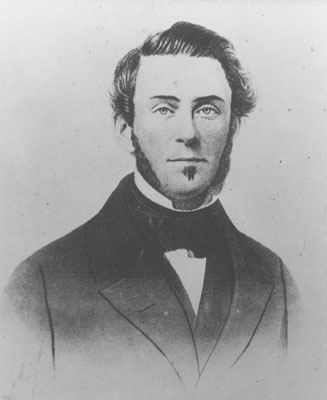 Indian Springs Resort has held its charm over the passage of time. “We hope in the near future we can come to agreement with the city on our expansion and make it happen,” says Pat. “Our three children—now grown—are helping with the expansion and have the same attachment to Indian Springs that we do. It’s a special place that we’ve rescued and revived and share with so many guests each year.
Indian Springs Resort has held its charm over the passage of time. “We hope in the near future we can come to agreement with the city on our expansion and make it happen,” says Pat. “Our three children—now grown—are helping with the expansion and have the same attachment to Indian Springs that we do. It’s a special place that we’ve rescued and revived and share with so many guests each year.
What might Sam Brannan think if he were to walk the grounds of Indian Springs Resort today? “Sam would have enjoyed the ride with us,” says Pat. “He was a dreamer, too, much like John.”


